The ongoing growth of wellbeing as a social trend is having a significant effect on the way towns and cities are designed. In fact, the Global Wellness Institute’s 2018 Build Well to Live Well report forecasts that the global market for wellness-focused property is expected to be worth $198bn by 20221, says David De Sousa, Director of AHR.
AHR
Both the private and public sectors are sitting up and taking notice of this and increasingly using wellbeing as a way to future-proof the regeneration of towns and cities. For instance, initiatives such as the WELL Standard and NHS Healthy Towns set out guidelines on how to design and regenerate in a way that maximises wellbeing, with the latter ultimately aiming to ease pressure on the health service by making sure health is part of people’s everyday lives.
But alongside this increasing focus on wellbeing, the built environment is also challenged by meeting a range of new demands. Sustainability and the UK’s ambitious net-zero carbon targets are one key area. The housing crisis is another, with the charity Shelter estimating that three million new homes are required in the next 20 years(2). Meanwhile, on the high street, research from the BBC shows that consumers are now spending one in every five pounds online(3).
New regeneration projects for towns offer an invaluable opportunity to reshape urban centres in a sustainable way that both promotes wellbeing and addresses the effects of the ongoing disruption across property sectors. Incorporating wellness using barometers like the WELL Standard and improving issues like sustainability with design initiatives like Passivhaus are increasing trends as a result.
As well as being altruistic, there are a wealth of commercial benefits to focusing on wellbeing. It creates healthy, sustainable communities while also future-proofing spaces for decades to come.
Rather than re-inventing the wheel to do this, the property sector can take inspiration from towns and cities of the past in its approach. In doing so, the sector could incorporate health and wellbeing into the fabric of regenerated schemes.
Cities of the past for the future
Though wellbeing-focused design has grown in popularity in recent years, this trend began in antiquity, with Greek and Roman cities placing the health of citizens at the heart of urban centres.
One way ancient civilisations created healthy towns and cities is by centralising amenities and community facilities. By creating centres that combined a mixture of uses, including temples, baths and other leisure and community facilities, they provided a space that encouraged socialisation and exercise for all generations. This approach was informed by high-profile architects of the age such as Vitruvius, whose principles inform how we design to this day(4).
In ancient communities, there was also a recognition that healthcare facilities must be central to the infrastructure of towns. The Greek city of Epidaurus, for instance, was built entirely around its health centre, The Asklepieion, quite literally placing wellbeing at its core.
Placing this ancient approach to healthcare at the heart of modern towns marries well with new NHS plans such as the ‘Five Year Forward View’, which has identified that the changing face of towns and cities offers us the opportunity to reshape the way health and social care is delivered. The benefits of new approaches like this have also already been demonstrated in some regions. For instance, NHS social care hubs across Wakefield have seen 2000 patients over six months, significantly relieving pressure on local GPs(5).
Mixed-use developments that incorporate healthcare provision are a fundamental part of how it will be provided to local communities in the future. At our Manor Street scheme for Braintree District Council, healthcare was prioritised in this way. The mixed-use development includes a new healthcare provision, Mid Essex CCG’s first Live Well Hub, at its heart – key to unlocking the regeneration’s growth potential and bringing life back to the town centre, tailored to meet the current and future needs of the area’s growing population.
Innovative new NHS initiatives driven by technology, including Manor Street’s Live Well Hub, will provide residents with easy access to more integrated health and wellbeing services. This healthcare provision is in many ways an anchor to a broader scheme, which includes a variety of uses – 35 new homes, a 70-room hotel, a new bus interchange, a two-storey car park and enhanced public realm – to create a liveable and healthy town centre.
Landscaping and green space also played a key role in ancient communities and should also be a key element of modern, wellness-focused design of towns and cities. It’s proven that good-quality green spaces improve health outcomes and reduce health inequality according to research by Public Health England and the Institute of Health Equity at University College London. A focus on landscaping also supports the creation of pedestrian- and cyclist-focused communities that have improved air quality and resident health.
At Manor Street, a publicly accessible garden forms the centrepiece of the scheme. It offers a green space for residents to use that complements the local area and the historic Grade II Listed Braintree Town Hall, that brings the entire scheme’s wellness credentials to life.
A similar approach informed our design at Westwood Village in Thanet, Kent. The development comprises 1430 new homes and 50 units for specialist housing and a primary and secondary school. The focal point of the scheme’s masterplan is a large, open central space for community interaction, which is complemented by green corridors and recreational and ecological routes that provide an area for children to play in.
Site boundaries are also generously landscaped with trees, native hedgerows and wildflowers which improve biodiversity. Green space and walkability form the core of the scheme’s design. This is in line with the National Institute for Health and Care Excellence’s recommendations that pedestrians and cyclists are given the highest priority in the design of new towns and cities.
Collaboration is key
A productive and collaborative partnership between the public sector and the private sector will be vital to ensuring wellbeing sits at the core of how schemes are designed.
For new projects, a combination of skills from both sectors is the best way to achieve commercial success and social value on a regeneration scheme. This has been demonstrated by the Government’s One Public Estate: Building a Movement Through Partnership report, which outlines how partnerships accelerate the delivery of projects and help to overcome potential barriers(6). This ensures that wellbeing can be delivered in a way that has social and economic benefits.
Our regeneration of the Boden Mill site in Chard, Somerset, serves as an example of what can be achieved. This project, developed by Alliance Leisure on behalf of South Somerset District Council, will create a new library, community facilities and swimming pool, brought together in a sustainable wellbeing-focused design that is sympathetic to the local area’s history.
Working with the public sector on this project streamlined the community engagement process and allowed us to work collaboratively to integrate the Boden Mill development with the wider regeneration of Chard’s town centre.
Early engagement with the public sector and other stakeholders plays a key role in creating healthy places, as it gives invaluable insight into the requirements of the community, while also incorporating the advice of those working in healthcare and other regional public sector roles which can maximise the wellness of future residents(7).
Organisations and businesses from across the industry should take this opportunity to reshape our urban centres to ensure they serve their communities now and in the future. By taking inspiration from evergreen design principles from ancient civilisations, and using collaborative partnerships to apply them, we can create spaces that meet modern demands with wellness at their core.
Sources:

David De Sousa became a Director of AHR in 2016. With a breadth of experience across infrastructure, transport, civic and educational sectors, he has developed an expertise in residential and mixed-use sites. Much of his work requires the unlocking of difficult sites and taking these through complex planning and urban design challenges.










